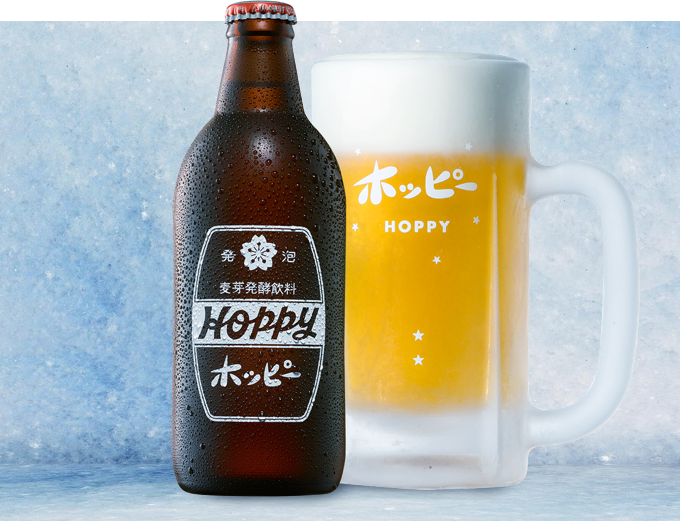
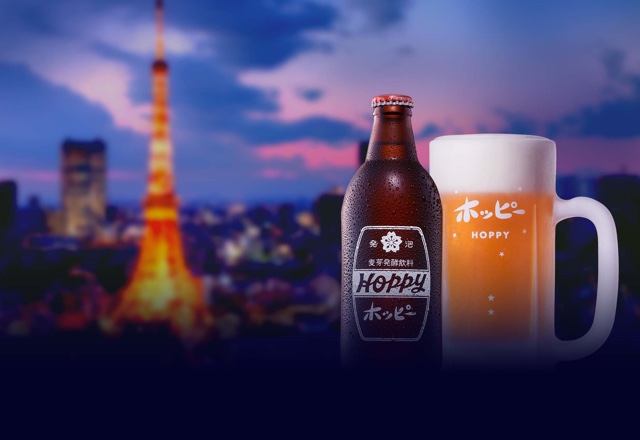
HOPPY SERIES

STORY OF HOPPY
HOPPY is a unique beverage first crafted in Akasaka district in Tokyo on July 15, 1948. The impetus for its development by founder Hide Ishiwatari was a non-alcoholic beer boom during the end of the Taisei era (1912-1936). During this period, he established Chikuma & Co., Ltd. in the town of Nozawa (currently located in Saku City) in Nagano Prefecture to manufacture the carbonated soft drink Ramune. This provided Hide the chance to acquire hops manufactured in Nagano Prefecture which a small business would normally have difficulty accessing, and opened the door to his fate. Non-alcoholic beer’s development had for the most part concluded prewar, and with the Showa era (1926-1989) Japan entered a period of war. The Ramune production plant in Akasaka was converted into a factory making flight instruments for fighter planes, and the non-alcoholic beer that Hide had created was also put on hold. At the end of the war in 1945 Akasaka had become a burned-out area, and it was once again Nagano Prefecture that came to the company’s rescue. Hide’s Ramune production plant in Nagano Prefecture had escaped wartime damage, and was relocated to Akasaka at war’s end. Here manufacturing of the already-developed HOPPY began at once. They considered calling the product “HOBBY” as this name encompassed the meaning of “a true non-alcoholic beer using actual hops,” something unprecedented at the time. However, because pronunciation was thought to be hard, it was christened “HOPPY” instead. Sales started with a focus on black markets in places like Shinbashi and Ikebukuro. At a time when beer was beyond the reach of ordinary people and only inferior alcohol was available, HOPPY exploded in popularity. It was used to cut this crude, smelly alcohol and enable it to be enjoyed, and it also allowed people to get drunk more quickly and cheaply than with beer. HOPPY is said to be a drink that aided in emotionally supporting the Japanese in their attempt to recover quickly from defeat. The style of drinking it mixed with shochu (Japanese distilled liquor) emerged from this social context. HOPPY has always remained close to the hearts of the Japanese people over the last 70 years, and it grew up alongside Japanese culture during this period. Via the creation of an original market, HOPPY has become the most unique beverage that is indispensable when telling the story of Japan’s mixer drink and alcohol history.
HOPPY
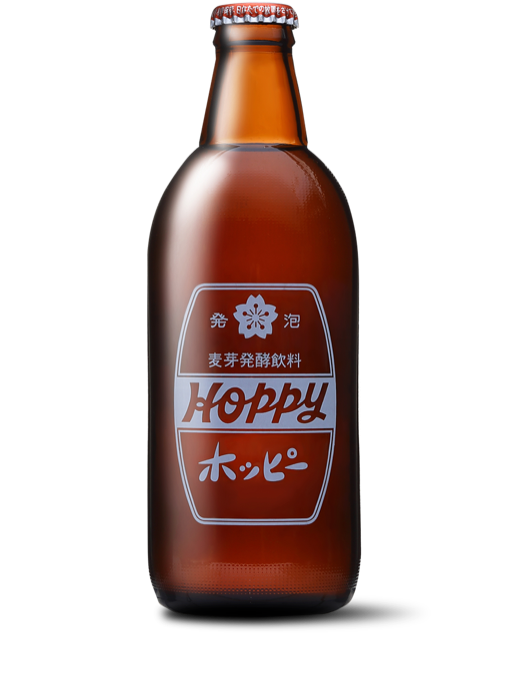
A health conscious beverage with low-carb, low-calorie, and no purine. Most enjoyed as a beer-tasting mixer with shochu that allows control of alcohol content depending on your mood, physical conditions, or preferred taste. A refreshing taste makes the drinking experience enjoyable and long lasting.
- Content
- 360ml
- Ingredients
- Malt, dehydrated starch syrup, glucose, starch, hops, acidulant, flavoring (amino acid, etc.)
- Alcohol
- About 0.8% *Distribution limited to Kanto region.

KURO HOPPY
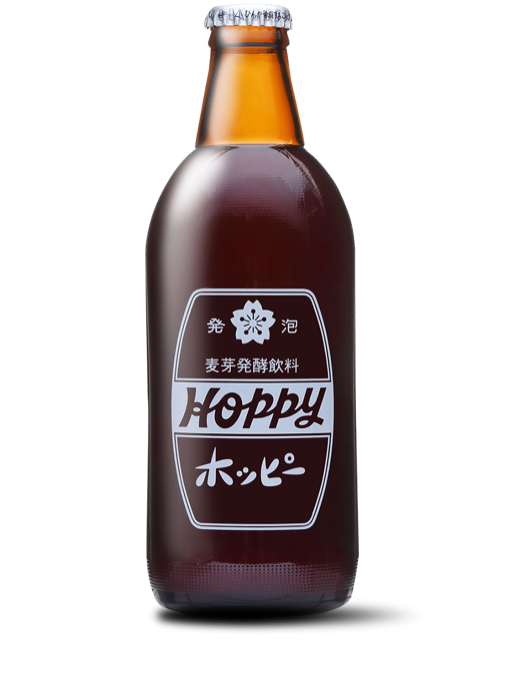
A health conscious beverage, 10 years in the making, with low-carb, low-calorie, and no purine. Made by blending four types of malt for a perfect balance between aroma and bitterness, the dark beer taste favored by the Japanese audience is known for the smooth sweetness.
- Content
- 360 ml
- Ingredients
- Malt, glucose, hops, acidulant, flavoring (amino acid, etc.)
- Alcohol
- About 0.8%*Distribution limited to Kanto region.

HOPPY330
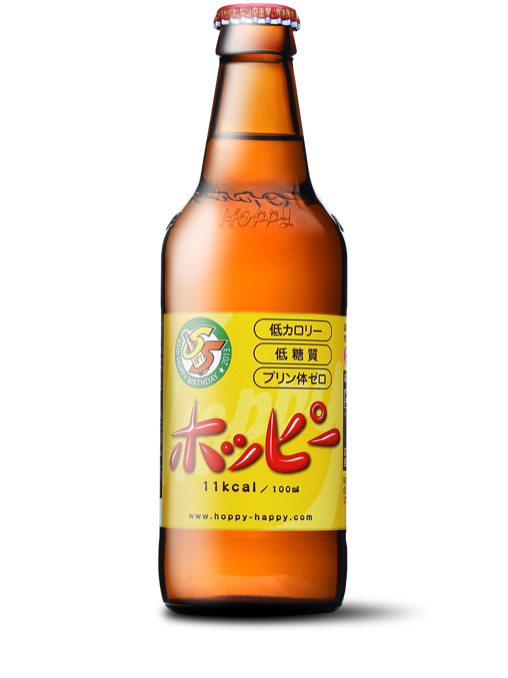
A health conscious beverage with low-carb, low-calorie, and no purine. Developed as a bottle sold for at-home consumption, its content is the same as HOPPY in stores.
*Please put out as recyclable garbage on days when your local government is collecting bottles. It will be recycled as raw material for glass bottles.
- Content
- 330 ml
- Ingredients
- Malt, dehydrated starch syrup, glucose, starch, hops, acidulant, flavoring (amino acid, etc.)
- Alcohol
- About 0.8%

HOPPY BLACK
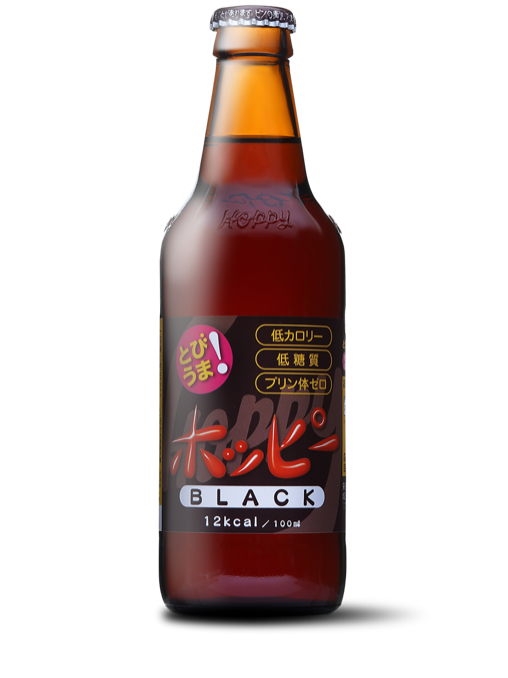
This health-oriented drink whose R&D took about a decade is low-calorie, low-carb and purine-free. Made by blending four types of malt and finding the perfect balance between aroma and bitterness, you can enjoy the smooth sweetness of this dark-type of beer favored by the Japanese. Developed as a bottle sold for at-home consumption, its content is the same as HOPPY in stores.
*Please put out as recyclable garbage on days when your local government is collecting bottles. It will be recycled as raw material for glass bottles.
- Content
- 360 ml
- Ingredients
- Malt, glucose, hops, acidulant, flavoring (amino acid, etc.)
- Alcohol
- About 0.8%

55HOPPY

2013 Monde Selection
Silver Award in the Beers, Waters and Soft Drinks category
Created to commemorate HOPPY’s 55th anniversary, this beer-like beverage makes full use of the fermented malt beverage’s unique technology. By using 100% malt and some deep-sea water, it is thoroughly and carefully aged over a period of time double that of typical brewing. Its taste is closest to that of actual beer, and the malts’ body and the hops’ refreshing aroma are perfect for quenching your thirst. Low-calorie, low-carb and purine-free.
- Content
- 330 ml
- Ingredients
- Malt, dehydrated syrup, glucose, hops, acidulant
- Alcohol
- About 0.8%

Table of Ingredients
HOPPY’s alcohol content is 0.8%, so please be careful when driving.
| Product | Alcohol (%) | Calories (kcal) | Protein (g) | Fat (g) | Sugars (g) |
|---|---|---|---|---|---|
| HOPPY | 0.8% | 11 | 0.1 | Less than 0.1 | 1.7 |
| KURO HOPPY | 0.8% | 12 | 0.1 | Less than 0.1 | 1.9 |
| HOPPY330 | 0.8% | 11 | 0.1 | Less than 0.1 | 1.7 |
| HOPPY BLACK | 0.8% | 12 | 0.1 | Less than 0.1 | 1.9 |
| 55HOPPY | 0.8% | 11 | 0.1 | Less than 0.1 | 1.7 |
- *Numbers are per 100 ml.
- *In accordance with the nutritional labeling standards set by the Consumer Affairs Agency, calories or nutritional components might be labeled as zero in the following cases:Calories: 5 kcal/100 ml; Protein: 0.5 g/100 ml; Fat: 0.5 g/100 ml; Sugars: 0.5 g/100 ml; Total Carbohydrate: 0.5 g/100 ml; Sodium: 5 mg/100 ml
